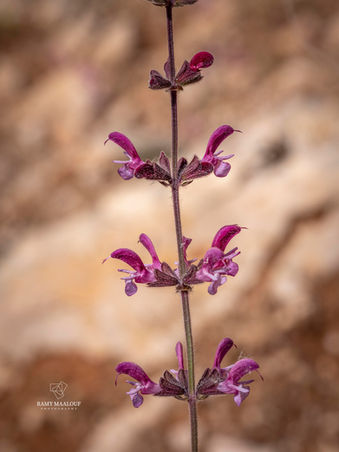Family |
Lamiaceae
Salvia hierosolymitana
Boiss.
Leb. Syr. Pal. Cy.
Salvia hierosolymitana Boiss.
(First published in Diagn. Pl. Orient. 12: 61 (1853), Nouvelle Flore du Liban et de la Syrie, vol. 3, Pl. LXXXIV nº 2; 1983)
• Life-form & habit: Perennial herb, 30–70 cm tall; stem erect, quadrangular, spinulose along the angles, otherwise glabrous, ending in a loosely branched, papillose and slightly viscid panicle.
• Leaves: Basal leaves long-petiolate, petioles papillose; blades green, thinly membranous, slightly papillose-rugose, broadly ovate to obtuse, cordate at the base, coarsely lobed, with shallowly denticulate lobes. Cauline leaves sessile, smaller; floral leaves very small, oblong, acuminate.
• Inflorescence & flowers: Verticillasters distant, with 6 flowers. Calyx reddish, papillose-glandular; upper lip slightly longer and recurved, with 3 nearly equal subulate teeth; lower lip with 2 long subulate teeth. Corolla dark red, 2–2.5 cm long, about three times the length of the calyx; upper lip strongly arched. Stamens and style long-exserted and soon deciduous.
• Fruit: Nutlets ovoid, smooth and dark brown at maturity.
• Phenology: Flowers April – June.
• Habitat & elevation: Grassy places, open hillsides and woodland margins; 100–900 m.
• Lebanese distribution: Documented in southern Lebanon (Tyr, Saïda), Nahr el-Kelb, ʿAïtate above Choueifat, Deir el-Qamar, ʿAbey, Chouit-ʿAraya, Chahtoul, Jabal Terbol, Khan Muhammad ʿAli, Hasbani.
• Native range: Cyprus, Lebanon–Syria, Palestine.
• ⚠️ Taxonomic note: Readily recognised by its dark crimson corolla, arcuate upper lip, and papillose-viscid calyx; among Levantine sages it may be confused with S. palaestina but differs by its glabrous stems, cordate-lobed leaves, and markedly red corolla.



